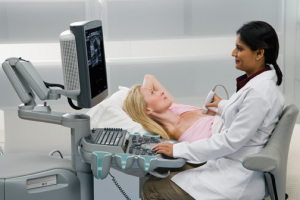by
Astrid Fiano, DOTmed News Writer | December 01, 2009

Breast ultrasound may
soon gain accuracy
through elastography
Pictured: Siemens
Acuson S2000
The annual meeting of the Radiological Society of North America (RSNA) taking place in Chicago, IL has yielded new information regarding elastography.
According to an ongoing study presented at the RSNA meeting, elastography is an effective, convenient technique to add to a breast ultrasound in order to better distinguish cancerous breast lesions from benign results.
The study is called The Role of Elasticity Imaging (EI) in a Large Community-based Breast Imaging Center. The study involved 135 patients ranging from 18 to 92 years of age, consenting to have EI at the time of hand-held breast ultrasound. Any solid lesions went on to the process of needle core or fine needle aspiration biopsy. Images acquired included standard B-mode and EI ultrasound images. Data was recorded on lesion laterality and location, mammographic and sonographic characteristics as well as type of biopsies, biopsy results, and open surgical biopsy results. The patient demographics were also noted in the study.



Ad Statistics
Times Displayed: 132698
Times Visited: 7564 MIT labs, experts in Multi-Vendor component level repair of: MRI Coils, RF amplifiers, Gradient Amplifiers Contrast Media Injectors. System repairs, sub-assembly repairs, component level repairs, refurbish/calibrate. info@mitlabsusa.com/+1 (305) 470-8013
When imaging cancer,
the area is larger on
the elastogram (right)
than on ultrasound
Effective at Spotting Cancer
The study found that EI was effective at identifying cancerous breast lesions, and the process had properly identified 98% of lesions biopsied as having malignant findings. In biopsied benign lesions, EI properly identified 76% of the lesions. The abstract states that EI "could have impacted the decision to forgo biopsy in these cases." Elastography was also more accurate than ultrasound in gauging the size of the lesions.
The RSNA notes that ultrasound is often used to yield more information when a mammography offers possible suspicious results. But because of the low specificity inherent in ultrasound, cancerous lesions are hard to distinguish from benign lesions.
"There's a lot of room to improve specificity with ultrasound, and elastography can help us do that," said the study's lead author, Stamatia V. Destounis, M.D., a diagnostic radiologist at Elizabeth Wende Breast Care, a large, community-based breast imaging center in Rochester, NY, in an RSNA press release. "It's an easy way to eliminate needle biopsy for something that's probably benign."
Elastography has the potential to reduce unnecessary breast biopsies because it can improve the specificity of ultrasound through measurement of the compressibility and properties of a particular lesion. The stiff nature of cancerous tumors compared to healthy tissue or benign cysts means a more compressible lesion on elastography is less likely to be malignant.
"You can perform elastography at the same time as handheld ultrasound and view the images on a split screen, with the two-dimensional ultrasound image on the left and the elastography image on the right," Dr. Destounis further stated.
Coauthors are Andrea L. Arieno, B.S., Melissa N. Skolny, M.S., Renee Morgan, R.T., Patricia Somerville, M.D., and Philip F. Murphy, M.D.
Adapted in part from an RSNA news release.
Read more about it:
RSNA release: http://www.rsna.org/Media/rsna/RSNA09_newsrelease_target.cfm?id=441
Abstract: http://rsna2009.rsna.org/search/event_display.cfm?em_id=8003134&printmode=y&autoprint=n

